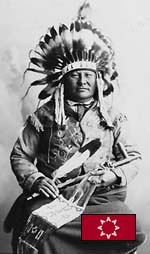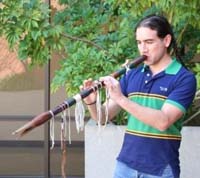
Intertribal Music
Many traditions have been shared at mixed tribal gatherings since time immemorial. These gatherings tended to occur at important annual ceremonials, from First Fruit ceremonies to healing ceremonies. Especially among hunter-gatherers, who typically split into small bands during the winter, seasonal gatherings were social occasions to visit with family and friends (perhaps from different tribes), for courtship, and for trading and bartering.
Gambling traditions were especially given to pan-tribal participation, and were and are still accompanied by special luck-songs.
Drum and flute traditions also crossed cultural lines.
In this chapter, two popular contemporary intertribal performance styles, both with roots in the past, will be presented: flute playing and pow-wow singing and dancing.
Flute Performance: Traditional to Contemporary
In contemporary North America, native flute playing is widely symbolized by the image of Kokopelli, the hump-backed flute player featured in petroglyphs, who was a symbol of fertility in the Southwest. But in pre-contact times, flutes had a number of associations, including courtship on the Great Plains, use in curing rituals in the Northeast, and playing of the flute as a signal of peaceful intentions by travelers when approaching a settlement in the Southeast.
Composer: 0
-
"Omaha Wind Song"
Flute melodies were most often derived from vocal songs and performed by the player on the flute in alternation with the sung version. In Lakota (Northern Plains) society, men played flutes during courtship in an attempt to make women fall in love with them.
The Lakota way of courtship was complex: A man not only had to win the heart of a woman, he also had to convince her parents that he was capable of supporting her. So before a young man could even consider looking at a woman, he had to prove his desirability by earning war honors, killing buffalo or other large, dangerous animals, or stealing horses as a gift for his potential wife's parents. When a young man felt he was finally ready for marriage, he would go winole (to seek a woman).
His first stop was at the home of the local "Elk Dreamer," a man who claimed special "medicine" or powers over women. The Elk Dreamer would give the young man a flute called a Siyotanka-a flute with the open end carved and painted like the head of a waterfowl-and a special love medicine song, with the power to enchant the selected young lady. These love songs, called Wioste Olowan, had both melodic and vocal/textual components.
"Inkpataya Toki Ya" is an old and well-known flute love song.
Composer: 0
-
"Inkpataya Toki Ya"
|
Lyrics |
|
I am standing where the water begins
I wave a blanket My goodness, my goodness Come back over here |
|
Translation by Calvin Jumping Bull |
Traditional Lakota performance practice had the man sit outside of his intended's lodge in the early evening, first playing the song on the flute and then singing the same melody with a text about love. If the song was powerful enough, the young woman would fall in love with him. If not, then the spurned suitor reconfigured the text into a kind of teasing song, sung from a woman's point of view. The song text in "Inkpataya Toki Ya" has undergone that transformation and entered the larger Lakota musical repertoire as a song about a woman of loose morals waving her blanket at men as they pass by, inviting them over for a visit.
From the 1890s though the late 1960s, flute performance traditions (including the art of making flutes) nearly died out, kept alive by only a few elders such as Richard Fool Bull (Lakota) and Belo Cozad (Kiowa). Beginning in the early 1970s, Comanche flute player Doc Tate Nevaquaya single-handedly revived the Native flute playing tradition, creating new songs inspired by programmatic influences such as the weather and beauty of the seasons, the Oklahoma landscape, and personal relationships with others.
Since that time, Native American flutes have gained in popularity with both Indian and non-Indian musicians. Important players and teachers today include Kevin Locke (Lakota), Edward Wapp (Comanche/Sac and Fox), Arnold Richardson (Tuscarora), R. Carlos Nakai (Navajo/Ute), and Mary Youngblood (Lakota).





Competition singing, known as Inuit throat singing, was done by both men and women in the Northwest Coast and among Inuit and other Arctic peoples.






